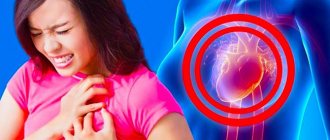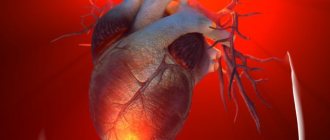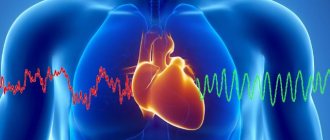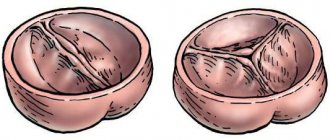What is it - bypass surgery of the coronary vessels of the heart after a heart attack? This operation is also called revascularization; it involves creating anastomoses (additional communications between vessels) to restore normal oxygen supply to the heart.
The need for this method arises due to coronary heart disease - a condition that is caused by a decrease in the lumen of the heart vessels.
The main cause of this disease is the formation of atherosclerosis, in which the development of atherosclerotic plaques is observed.
Purpose
A heart attack is a consequence of coronary heart disease. Under these conditions, the heart does not receive the full amount of oxygen and nutrients from the vessels. To restore normal blood supply, various surgical methods are used, including coronary bypass surgery.
This operation is used to eliminate angina pectoris and reduce the frequency of patient hospitalization as a result of exacerbation of the disease.
INFLUENCE OF BEER ON THE HUMAN HEART
The work of the heart, like the entire cardiovascular system, is important for the functioning of the entire human body.
There are many factors that go into making this system work properly.
For example, it depends on the environmental situation in which you live, what job you work, what lifestyle you lead, genetic characteristics and what you eat.
There have been various discussions about the dangers of alcohol for a long time. All kinds of alcoholic drinks have different effects on all human organs, but it has long been scientifically proven that there is deep harm when drinking alcoholic beverages.
But many people are sure that beer is a low-alcohol drink that does not need to be given special attention, that when consumed it does not have a negative effect on the body, but on the contrary, when drinking beer it even restores the body and makes the flow of certain mechanisms even better.
But this is just a huge misconception, since beer only has a negative effect on absolutely all systems and organs of the human body.
FACTS ABOUT THE INFLUENCE OF BEER ON THE CARDIOVASCULAR SYSTEM
Scientists have long proven that drinking beer leads to addiction, thereby beer increasingly accumulates negative effects in the human body, which sooner or later will lead to some kind of disease.
- Initially, beer has a detrimental effect on the heart, namely, it forces it to do double work. It becomes more and more difficult for the heart to pump blood and pump it out. If a person continuously drinks about 2 liters of beer, then the load on the cardiovascular system should take on twice the usual load. When the load falls on the heart, the pressure gradually begins to increase. And as you know, this can lead to a disease such as hypertension, which leads to severe complications for the entire body.
- Hypertension is not so easy to cure. Many people think that they can stop drinking a foamy drink, and their blood pressure will be restored and hypertension will disappear. But hypertension cannot disappear without a trace; it will have to be fought all the time. And if you start treatment for this disease, you can get a stroke or heart attack. Due to problems associated with blood pressure and the appearance of hypertension, there is a possibility of developing atherosclerosis.
- Atherosclerosis is a very dangerous and terrible disease that gradually leads to the entire vascular system becoming damaged. A certain vessel may completely die, or only a separate part of it will die. Due to the fact that a person has atherosclerosis, he may develop coronary heart disease. As a rule, this disease occurs in older people, but, unfortunately, in the modern world there is a tendency to acquire diseases at an earlier age.
- Coronary artery disease is very difficult to cure; it will not go away if you just take pills. In most cases, surgery is necessary. Also, due to the appearance of a disease such as coronary heart disease, a person can acquire a number of serious diseases arising from these diseases.
- Most often, a person becomes a victim of myocardial infarction. A person who has suffered from this illness may undergo a very long recovery process. According to statistics, it is because of coronary heart disease that a third of the population who had heart problems dies.
Beer contains a metal called cobalt that is dangerous to the human body. It can be assumed what negative effects a chemical element causes when it enters the human body. First of all, cobalt negatively affects the functioning of the heart, namely, it has a destructive effect on all the walls of blood vessels.
Most people who start drinking beer never get enough. Firstly, because it leads to alcoholic intoxication a little slower than other alcoholic drinks. And secondly, because it causes addiction to its use.
“BEER HEART” SYNDROME - WHAT IS IT?
When a person drinks foamy drinks regularly and in large quantities, then most likely the person will develop a syndrome called “ beer heart .” This is not a funny name, but a series of changes in the body that lead to the normal functioning of many systems in the body.
Firstly, the heart becomes larger in size, which prevents the nervous system from functioning normally.
Also, excessive consumption of beer leads to the acquisition of a disease such as myocardial dystrophy. This is a disease that affects the heart muscle. A metabolic disorder occurs in the muscle, which is caused by the inability to normally perform its certain functions. In this case, the heart cannot work at full strength, which is why a person experiences pain in the heart area, shortness of breath appears, especially when performing any physical activity, and the person also experiences groundless weakness, swelling of the limbs and lethargy. A person ceases to have the desire to do anything, to perform work, and performance, accordingly, decreases.
If a person does not go to medical institutions on time, this is fraught with the development of heart failure.
With prolonged drinking of beer, the heart not only becomes larger in size, but also generally changes its structure. This leads to the development of a disease such as alcoholic cardiomyopathy . This is due to the fact that beer contains cobalt and ethanol, which cause destructive effects on the body.
It all starts with pain in the heart area, the skin begins to change its normal color to the appearance of blue or red on it. The person also experiences shortness of breath, and the legs and arms begin to swell. A weight loss occurs: a person can either lose weight sharply or gain weight sharply. Sharp swings in mood occur, and a depressive state may appear. The pressure will constantly “jump”, and a constant cough will appear. As a result, a person dies, as irreversible processes occur in the body.
If a person is diagnosed with a similar disease, then judging by medical practice, such people live for a maximum of 3 years with the constant manifestation of certain symptoms. The difficulty is that this disease is very difficult to recognize, since this disease does not have its own symptoms. The symptoms of this disease are very similar to other heart diseases. When contacting a doctor with such symptoms, you need to answer questions honestly, and be sure to tell them if you have been drinking beer for a very long time and a lot.
FOR WHAT DISEASES YOU SHOULD STRICTLY NOT DRINK BEER
Drinking beer can turn an absolutely healthy person into a sick or even disabled person. But there are a number of diseases for which drinking beer is strictly prohibited, as it can be fatal.
- If a person has a heart rhythm disorder, namely arrhythmia, then drinking beer should be avoided forever, since arrhythmia in most cases is not one disease, but is also caused by other diseases of the cardiovascular system. This disease is dangerous due to the fact that a person cannot always recognize its symptoms, which at first occur painlessly in the body. As a result, a third of sudden deaths are due to arrhythmia. If you drink beer during arrhythmia, the load on the heart increases significantly and it becomes even more difficult for the heart to perform its functions.
- This also leads to disruption of the normal functioning of the central nervous system , which is caused by frequent fainting, weakness, fatigue, depression, frequent headaches, and also problems with lung function.
- If a person has angina pectoris, manifested by pain in the heart area, frequent attacks. This pain occurs due to the fact that the heart does not receive enough oxygen. In the presence of this disease, cholesterol accumulates on the walls of blood vessels. When drinking beer, there is a colossal load on the liver; the liver cannot cope with its work and cannot remove cholesterol plaques. Thus, a person may develop other diseases associated with the fact that cholesterol accumulates in large quantities on the walls of blood vessels. Also, beer can lead to an increase in attacks that occur with angina pectoris.
- If a person suffers from coronary heart disease, then drinking a foamy drink can lead to numerous attacks, heart attacks and strokes. The heart cannot cope with the load, and the person may remain disabled or die.
- Drinking beer if you have vascular or heart diseases is simply impossible and prohibited.
Due to human stupidity associated with drinking beer, anything can happen. As a rule, a person with illnesses always takes pills.
It is prohibited to combine any alcoholic beverages with medications, as the reaction to this mixing can be very disastrous. Thus, the disease may develop, or a new disease may be added.
HARM OF TRADITIONAL SNACKS
Drinking beer is never complete without various snacks. Most often these are chips, crackers, and various smoked meats. All this is poison for the body, made from low-quality products, filled with salt and spices.
Eating such snacks together with beer also puts a serious strain on the body. A person develops swelling, it becomes increasingly difficult for the kidneys and liver to cope with their functions, and this leads to disruptions in the functioning of the heart.
Indications
Cardiac bypass surgery can be used both in the presence of basic indications and in the case of certain conditions for which this method is recommended. There are three main indications:
- Obstruction of the left coronary artery exceeds 50%;
- The diameter of all coronary vessels is less than 30%;
- Severe narrowing of the anterior interventricular artery in the area of its origin in combination with stenoses of the other two coronary arteries.
If the patient suffers from angina, coronary artery bypass grafting can reduce the risk of relapses, in contrast to symptomatic drug or alternative treatment. In case of a heart attack, this method eliminates cardiac ischemia, as a result of which blood supply is restored and the risk of repeated incidents is reduced .
The essence of the method
In coronary artery bypass surgery, a shunt (connection) is created between the affected area and a healthy artery . Most often, parts of the internal mammary artery and saphenous vein of the thigh act as a graft. These vessels are not vital, so they can be used in this operation.
Shunts made from arterial sections are more durable and reliable than those made from veins. According to statistics, about 30% of venous anastomoses close in the next 6-7 years, while 95% of arterial anastomoses continue to function after 15 years.
Bypass surgery can be performed either while the heart is beating or using a heart-lung bypass (CPB) machine, although the latter method is more often used. The decision about which one to choose depends on the presence of various complications in the patient, as well as the need for concomitant operations.
Preparation for the event
Preparation for bypass surgery includes the following aspects :
- The patient should take his last meal no later than the day before surgery, after which drinking water is prohibited.
- At the site of the operation (chest, as well as the site of transplant removal), the skin should be free of hair.
- In the evening of the previous day and in the morning, it is necessary to empty the intestines. You should take a shower on the morning of surgery.
- The last act of taking medication is allowed no later than the day before after a meal.
- A day before bypass surgery, an examination is carried out with the participation of the operating doctor and accompanying personnel in order to draw up an action plan.
- Signature of all necessary documents.
What should a person’s pulse be: the norm for age, heart rate and rhythm are discussed in our materials.
Is a heart rate monitor useful for running with a chest strap and how to choose the right device? Find out about it here.
Is it worth purchasing a wrist-based heart rate monitor, how accurate and effective is it, and is it suitable for running? Read the next article for all the details.
Technique for performing on vessels
How is heart bypass performed? An hour before the operation, the patient is given sedatives. The patient is taken to the operating room and placed on the operating table. Here, devices for monitoring vital function parameters (electrocardiogram, determination of blood pressure, respiratory rate and blood saturation) are installed, and a urinary catheter is placed.
General anesthesia is then administered, a tracheostomy is performed, and the operation begins.
Stages of coronary bypass surgery:
- Access to the chest cavity is provided by incision in the middle of the sternum;
- Isolation of the internal mammary artery (if mammary coronary bypass surgery is used);
- Graft collection;
- It is connected (IC) with hypothermic cardiac arrest, and if the operation is performed on the working heart, then devices are applied that stabilize a certain area of the heart muscle in the place where the shunting occurs;
- Shunts are placed;
- Resumption of heart function and shutdown of the artificial heart-lung apparatus;
- Suturing the incision and installing drainage.
Not for the faint of heart or minors! This video shows how coronary artery bypass surgery is performed.
Heart bypass surgery: how the operation is performed
For what diseases should you not drink it?
It is obvious that drinking beer with already identified cardiovascular diseases is fraught with a deterioration in the condition, an abrupt increase in blood pressure, the progression of existing diseases and the development of new ones.
- Arrhythmia. Thus, with arrhythmia, drinking beer, in addition to placing a critical load on the heart muscle, contributes to a deterioration in the functioning of the central nervous system, causing fainting, dizziness, and impaired lung function.
- Angina pectoris. Consumption of beer during angina pectoris is dangerous for attacks and progression of the disease, since liver dysfunction due to alcohol intoxication prevents the removal of cholesterol plaques and contributes to the development of the disease that is the root cause of angina pectoris, that is, vascular atherosclerosis, which occurs due to the deposition of cholesterol on the walls of blood vessels.
- Ischemia. With coronary artery disease, beer consumption greatly increases the risk of heart attacks, heart attacks and strokes.
Drinking alcohol in the presence of identified diseases of the cardiovascular system nullifies efforts to treat them. In addition, combining medications with alcohol is not allowed, since together they can lead to unforeseen consequences, for example, collapse when combining alcohol with medications designed to normalize blood pressure and vascular activity.
See also:
- How coffee affects the cardiovascular system: a review of studies.
- 9 fruits and vegetables our hearts need.
Rehabilitation in the postoperative period
Immediately after the operation, the patient is transported to the intensive care unit, where he remains for several days, depending on the severity of the operation and the characteristics of the body. For the first 24 hours he needs a ventilator .
When the patient can breathe on his own again, he is offered a rubber toy, which he inflates from time to time. This is necessary in order to ensure normal ventilation of the lungs and prevent congestion. Provides constant dressing and treatment of the patient's wounds.
After one to two weeks, the skin at the incision site heals and the patient is allowed to shower.
With this method of surgical intervention, the sternum is dissected, which is then fastened using the method of metal osteosynthosis. This bone is quite massive, and if the skin in this area heals relatively quickly, then it takes several months to six months to restore the sternum . Therefore, patients are advised to use medical braces to strengthen and stabilize the incision site.
Also, due to blood loss during surgery, the patient experiences anemia, which does not require special treatment, but to eliminate it, a richer diet, including high-calorie foods of animal origin, .
Normal hemoglobin levels return after about 30 days.
The next stage of rehabilitation after coronary artery bypass surgery is a gradual increase in physical activity . It all starts with walking along the corridor up to a thousand meters a day, with a gradual increase in load.
Upon discharge from the medical institution, the patient is recommended to stay in a sanatorium for complete recovery.
Treatment and prevention
In an inpatient setting, the patient is monitored around the clock. Doctors act strictly according to the intensive care protocol, monitor and control the patient. With the help of drugs, the condition is stabilized and hemodynamics are restored. In some cases, emergency surgery is performed, coronary artery bypass grafting is performed.
The postoperative recovery period is individual for everyone. Sometimes pain in the heart may occur after a heart attack; therefore, it is necessary to constantly be under the supervision of a cardiologist and follow the recommendations prescribed in the extract.
To prevent a heart attack from happening again, you need to radically change your lifestyle and monitor the level of “bad” cholesterol, which should be significantly less than 100 mg/dl.
Physical activity is an integral part of rehabilitation therapy; exercises must be performed at least 5 days a week for 30–60 minutes. (as prescribed by a doctor).
It is necessary to completely eliminate both active and passive smoking.
Emotional therapy speeds up the process of recovery of the body after an illness. Many doctors prescribe antidepressants in order to avoid the onset of depression, as a result of which the patient may irregularly take medications that support normal heart function.
FacebookvKontakteTwitterWhatsApp
Advantages of this method
The main question regarding the benefits of coronary artery bypass grafting is its comparison with cardiac stenting. There is no consensus on when one method should be preferred over another, but there are a number of conditions under which coronary artery bypass grafting is more effective:
- In case there are contraindications to stenting, and the patient suffers from severe angina, which interferes with the fulfillment of everyday needs.
- Several coronary arteries were damaged (three or more).
- If, due to the presence of atherosclerotic plaques, a cardiac aneurysm is observed.
High cholesterol in the blood - what does it mean and when is medical help needed? We will tell you all the details!
Should I be concerned about low blood cholesterol, is it good or bad? Read all about it on our website.
Read about what the normal blood cholesterol level should be in adults here.
Diagnosis of the problem
Bavarian beer heart syndrome is difficult to diagnose due to the similarity of symptoms of most pathological processes of the cardiovascular system. When visiting a specialist, patients do not like to disclose their addiction to the foamy drink. This situation makes it difficult to make an accurate diagnosis. At the moment when the disease is identified, it may already be at the second and third stages of development, which entails difficulties in treatment. At this time, the body has already undergone irreversible damage.
When the disease occurs, a characteristic murmur is heard in the heart area. On palpation, a lump is felt. If the doctor suspects beer heart syndrome, he may prescribe the following procedures to the patient:
- Electrocardiogram.
- Radiography.
- Ultrasound of the heart.
- Echocardiography.
If it turns out that the patient abuses alcohol, he will be referred to a consultation with a narcologist, where he will be asked a series of simple questions. The answers to them will help you understand the degree of dependence.
Consultation with a narcologist
Contraindications
These include : versatile damage to most coronary arteries, a rapid decrease in the ejection function of the left ventricle to a level below 30% due to focal scarring, the inability of the heart to pump the amount of blood necessary to nourish the tissues.
In addition to specific ones, there are general contraindications , which include concomitant diseases, for example, chronic nonspecific lung diseases (CNPD), oncology. But these contraindications are relative in nature.
Likewise, advanced age is more of a risk factor for surgery than a direct contraindication to coronary artery bypass grafting.
Possible consequences and complications after surgery
There are specific and nonspecific complications after revascularization of the heart muscle. Specific complications are related to the heart by the coronary arteries . Among them are:
- The occurrence of heart attacks in some patients and, ultimately, an increased risk of death.
- Damage to the outer layer of the pericardial sac as a result of inflammation.
- Impaired heart function and, as a result, insufficient nutrition of organs and tissues.
- Various types of arrhythmia.
- Inflammation of the pleura as a result of infection or injury.
- Risk of stroke.
Nonspecific complications include problems that accompany any operation.
What is the disease
Alcoholic cardiomyopathy is a disorder of the myocardial structure caused by the long-term toxic effects of ethyl alcohol and its metabolites on cardiomyocytes. It is characterized by diffuse damage to the heart muscle, ischemia of myocardial tissue and progressive heart failure.
In addition to the above, the disease has other names:
- alcoholic heart damage;
- beer heart;
- alcoholic myocardial dystrophy.
Typically, with cardiomyopathy, the heart becomes enlarged, stretched, deformed and becomes unable to perform its functions. This condition of the organ leads to heart failure, swelling, shortness of breath, and chest pain. Symptoms worsen after heavy drinking. In the absence of adequate treatment, severe complications develop, and in some cases death occurs.










